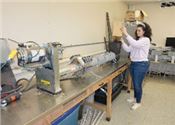LSU AgCenter Shines Light On Resistant Weeds

LSU AgCenter weed scientist Lauren Lazaro pours rice chaff into the hopper of her tabletop model of the Weed Seed Destroyer. The unit is a prototype of a model that will be attached to the rear of a combine to use blue LED light and heat to kill weed seeds.
Photo by Johnny Morgan/LSU AgCenter
JOHNNY MORGAN
BATON ROUGE, LOUISIANA
With the increase in herbicide-resistant weed varieties, researchers are examining new methods of control – including using blue light to target stubborn weed species.
LSU AgCenter weed scientist Lauren Lazaro is leading a study looking at the possibility of using blue LED light and mild warming to kill weed seeds at harvest.
Lazaro said she was contacted by Global Neighbor Inc., an Ohio-based company that is studying the use of different blue light levels and temperatures to kill weed seeds.
The Weed Seed Destroyer is a unit that bolts to the back of combines and saturates weed seeds with light and heat as it passes with the chaff flow during harvest.
The blue light technology is a non-chemical approach to stunting the growth of herbicide-resistant weed seeds, Lazaro said.
“The goal for the company is that this equipment will be bolted onto the combine at harvest and to combine blue light and temperature to make weed seeds unable to germinate,” she said.
Lazaro purchased a stationary, tabletop unit and has been using it to do some basic weed ecology research. While she points out that results from the tabletop model may differ from those from the on-combine unit, Lazaro has gathered some promising data.
She has examined different temperature ranges and exposure to blue light in soybean and rice weeds to determine weed seed kill rates and how morphological and physiological characteristics of emerging weeds are affected.
Lazaro said she further plans to test various chaff moisture levels to see how that may affect the Weed Seed Destroyer.
The unit is not ready for commercial application yet, she said, but her early studies are showing a 70 percent-to-90 percent kill rate on a number of weed seeds.
“We tested barnyardgrass, Palmer amaranth, morningglory, hemp sesbania, prickly sida and johnsongrass,” she said. “We saw higher kill rates, around the 93 percent range, on the smaller seeds like barnyardgrass, prickly sida and Palmer amaranth.”
She said there were mixed results for larger-seeded weeds, with johnsongrass showing a 90 percent kill rate and morningglory and hemp sesbania showing about 70 percent control.
Warming the seed not only can kill weed seeds, but at lower levels, heat can also stimulate crop seed growth.
“This is a much smaller model than the one that will be integrated into the combine, but it has already allowed us to do some studies in rice and soybean chaff,” she said.
The technology was developed through a grant from the U.S. Air Force, which was looking for ways to make tumbleweed seeds nonviable.
Jon Jackson, the innovator behind the Weed Seed Destroyer, said blue LED light could become a regular tool for weed control in farming.
“This unit utilizes mild warming and intense LED rays to saturate weed seed as it passes with the chaff flow during harvest, and the seed-killing device is ready for spring cutting trials in Tennessee wheat and Ohio barley,” he said. “This type of agriculture technology is developing faster than people know.”
Jackson said the Destroyer warms the seed to more than 100 degrees Fahrenheit and applies a blue LED light for several seconds at an intensity 20 times that of sunlight, which causes mayhem within the cell structures.
Lazaro said this technology is not expected to be a cure for all weed problems, but it is another tool for the toolbox.
“The use of directed energy at harvest should be integrated into an existing management plan and used as an additional tool for weed control,” Lazaro said. ∆
JOHNNY MORGAN: LSU AgCenter